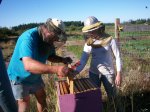 They say that if you get 10 beekeepers in a room and ask them a question, you’ll get 11 different opinions. This is solid truth. I’ve attended beekeepers meetings, helped as a volunteer at bee schools, read a few books on the subject and have been a beekeeper myself (with my dad) for about 10 years off and on. There are so many, many variables when you’re dealing with a single colony made up of several thousands of members who all are innately programmed for specific tasks that can change with the direction of the sun, the climate, the country, the food source, the chemicals present in their environment, the time of year and potential outside threats. That’s why no matter how many bee-related sessions I sit in on, I always learn at least 2 new things.
They say that if you get 10 beekeepers in a room and ask them a question, you’ll get 11 different opinions. This is solid truth. I’ve attended beekeepers meetings, helped as a volunteer at bee schools, read a few books on the subject and have been a beekeeper myself (with my dad) for about 10 years off and on. There are so many, many variables when you’re dealing with a single colony made up of several thousands of members who all are innately programmed for specific tasks that can change with the direction of the sun, the climate, the country, the food source, the chemicals present in their environment, the time of year and potential outside threats. That’s why no matter how many bee-related sessions I sit in on, I always learn at least 2 new things.
My dad and I started keeping bees when I was in about 7th grade. We went to the WNC bee school one February at the Ag. Extension Center and learned about bee breeds, hive components, pollen and nectar sources, diseases and pests and honey extraction and marketing. We took a test at the end of it all and came out ‘Certified Beekeepers.’ We started out with 3 hives, got a good harvest of honey the first year (they tell you not to expect anything the first year because the bees are taken up with establishing their new home and won’t often have extra for you to steal) due to a magnificent nectar flow year and have kept ourselves in a steady home supply of honey since. Even for the few years we didn’t have any hives due to curious mountain bears, we had enough stock to always be able to run down to the basement and pick up an 8 or 12 oz. jar when a mug of hot tea scraped our last spoonful or when honey truffles or cookies called for the last few slow drops.

We started with hives again 3 years ago and got 4; 2 Russian Carnelian hives and 2 Minnesota Hygienics (an Italian variety.) No honey our first year back this time, and only one super this past year. I haven’t been home in 5 months now, so I have no idea how they’re faring this hot summer back in the mountains of NC. But the bees here in western Washington are having the time of their lives (albeit relatively short ones) dancing and pollinating about in the unusual abundance of wild blackberry flowers. Lavender, clover and fireweed are also in the mix for this time of the year.
John of Spring Rain Farm here in Chimacum has about 20 hives in various places on his 2 properties; mostly survivor stock of swarms he’s caught and boxed. Due to so many having new homes in which to draw comb out, he’s able to harvest 6 medium (Western) supers of honey for home-use. He hosted a company of about 6 interns on different farms in the area for a bee management class on Thursday. He touched on everything from pollen and nectar sources and the gaps in the year when there isn’t anything blooming in this part of the country, to the position of the ‘brood nest’ in the hive body, to why he doesn’t use queen excluders, to how to combine or split colonies and insulate the hive itself for overwintering. It ended in all of us helping to uncap the frames of honey (from just 2 supers) and place them in the extractor to spin out for a final outcome of one-and-a-half 5-gallon buckets of honey. It’s the lightest, clearest honey I’ve ever seen. Most honey has a darker, amber or ruddy color to it, but this looks like lemonade.
Bees are the ultimate community gardeners, not only for their colonial community, but for the great communities of us and the other insects and plants nature has all around us. They pollinate, are super-hard workers, operate as a finely tuned team and make one of the sweetest end products imaginable. (Just don’t dwell on the fact that honey is actually regurgitated nectar.) They’re necessary for the life and next generations of hundreds of plants and they all look out of each other in the hive too, doing specific ‘dances’ to alert the other bees of intruders or dangers in the hive. They all work together to keep each other warm and cool and fed. They’re a great element of diversity on farms and gardens for their pollination performance, raising awareness of what’s in bloom and what type of pollination is suited to certain plants and of course honey.
